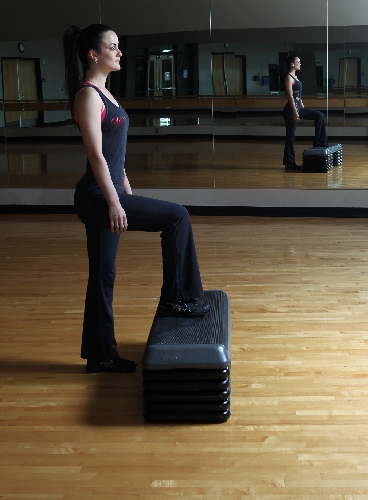Thigh high: A routine for stronger quads

I’ve never been a fan of skinny jeans because they don’t fit over my thighs. Not that skinny jeans ever fit over any but the thinnest thighs for that matter. I say down with skinny jeans and back to quadriceps that are big enough to function.
The quadriceps are composed of four large muscles, forming the front portion of the leg. The rectus femoris is on the top of the thigh. It attaches from the knee to the pelvis. The vastus medialis is on the inside of the leg next to the rectus femoris. The vastus lateralis is on the outside of the leg next to the rectus femoris. The vastus intermedius is also on the outside of the thigh. The vastus medialis and vastus lateralis are the two muscles above the knee that are easily seen when contracted, appearing as giant teardrops. They are the muscles that pop through the Spandex shorts of seasoned cyclists. Having a basic knowledge of leg muscles will help you focus on them during your quad exercises.
It’s smart to discuss the knee joint when talking about the quads since the quads are used to extend the knee. Many people suffer from some kind of knee pain. A number of issues can cause the pain. The knees also can make popping or cracking noises that usually are not of major concern. If you’re not certain of your condition, check with a physician before working your legs.
The lateral and medial meniscus act as a cushion between the bones by dispersing weight. The meniscus naturally moves forward when the knee is flexed and rotated. If movements are not controlled, the meniscus may not return to its correct position, leading to injury. The meniscus also can become worn away with time. Most sounds originating in the knee are related to the meniscus.
Tendons hold the bones together and serve to stabilize the knee and keep it from rotating when it is locked straight. When the knee is bent, the joint’s stabilization comes from muscles. If muscles are not conditioned then strain and overuse can lead to injury. These conditions can be very painful.
Those with knee issues may have a limited range of motion or be instructed not to perform certain exercises. Again, consult a physician before attempting new movements. When working the knee, it is important to be in control of your movements. It’s the best way to prevent injury.
Athletes use quads for every sport. They are some of the major muscles in running and jumping. Football players use them to explode off the line when the ball is hiked. Volleyball and basketball players use them to jump. Cyclists use them to pedal. Speed skaters use them to push past competition. Skiers and snowboarders count on them for stability.
The step up is a good exercise for the quads and the knee. I like it because it uses the other muscles in the legs to help stabilize the movement. I tend to prefer movements that use the entire leg because they will assist in building joint stabilization.
I’m careful about recommending the leg extension machine for clients as an exercise to work the quads. Adding too much weight on this machine while the knee is not stable can lead to injury. But the exercise can be effective if performed properly. When I use the leg extension, I combine it with a lighter weight and a slow tempo to allow the muscle tendons to strengthen over time. Executing this exercise in a fast and explosive motion is not advised. People with knee injuries may find the leg extension to be too much for their joints.
Some cardio machines also work the quads. The elliptical as well as the stationary and spin bikes can be effective tools in quad training. Some people with knee injuries find that cardio equipment doesn’t aggravate their knees and can even be beneficial.
If you have bad knees, go easy on them and if you want to avoid getting bad knees, control your movements.
Chris Huth is a Las Vegas trainer. You can contact him at 702trainer@gmail.com. Before beginning any exercise program, consult your physician.